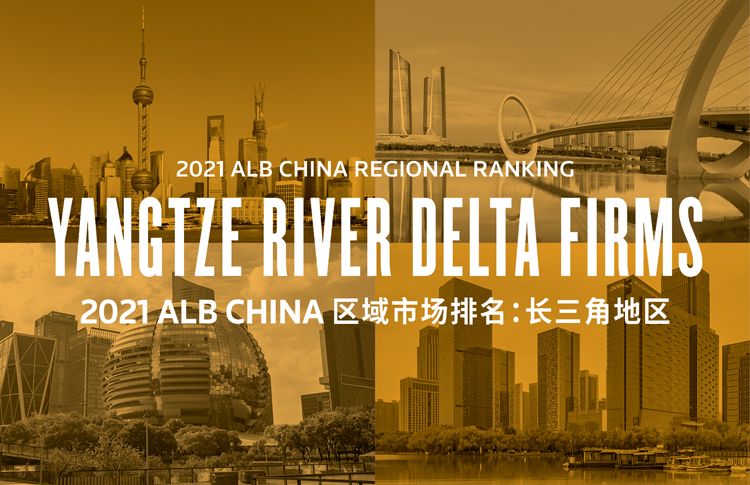
经过40余年发展,中国的法律服务市场日益壮大,区域性法律市场也发生着巨大变化,不断向前发展。在这份全新榜单中,ALB聚焦区域市场的杰出律所,评选出了长三角地区,即上海市、江苏省、浙江省、安徽省的顶尖律所。
2021年6月,ALB启动了第二个区域法律市场排名,这一次,我们将目光投向了中国版图中另一个重量级经济体——长三角。经过数月调研考察,这份长三角地区榜单呈现在了大家面前。榜单分为两个类别:长三角本地律所与非长三角本地律所,每个类别有15家律所入选,最终上榜律所共30家。
长三角本是个地理概念,但伴随2018年长三角区域一体化上升为国家战略、2019年国家颁布《长江三角洲区域一体化发展规划纲要》,长三角逐渐演变成为一个规划概念。今天,广义的长三角包含了上海及江浙皖三省共41 座城市,其中又由27座城市组成中心区。ALB的此次评选正是依据国家战略规划的长三角范围展开。
为什么是长三角?
长三角在中国经济版图中的重要地位已无需赘述:这里集中了中国约12%的人口,创造着约20%的GDP。长三角自古以来物产丰饶、经济发达且发展均衡,近年来伴随产业转移、合作,更形成了愈发良性的经济格局。
在长三角,上海是当之无愧的核心城市,如今被赋予了国际经济、金融、贸易、航运、科创五大中心地位,并以建设“全球城市”为定位。但上海之外,长三角也“无弱旅”,如苏州,和上海共同构成长三角内经济总量最大的城市组合;杭州与南京,一个以民营企业活跃为特色,一个具备强劲的国有企业影响力;合肥、南通等,则以极快的增长速度,成为该区域的“明日之星”。
这样的份量也体现在长三角的法律市场中。仅从律师人数上就能直观感受长三角的影响力:根据各地律协截至2020年底的数据,上海律师人数为3.16万人,浙江为2.73万人,江苏为3.56万人,安徽为1.59万人,四地总和占中国律师总数约22%。
因此,在这份ALB长三角榜单中,我们也力图展现出这一地区的丰厚实力,呈现长三角市场最为顶尖的法律服务提供商。为达到这一目的,我们的调研标准既“言实”,又“务虚”,既着重考察了律所在长三角地区的办公室和人员数量、市场规模、综合业务实力、客户组成等信息;也收集探索了它们在这一地区的自身定位与发展策略;最后,我们还适当兼顾了该区域内的平衡性。
未来,借由高度一体化和市场要素高效流通,长三角将继续在中国经济增长中发挥至关重要的作用。这为该区域法律市场的高速发展奠定了基础,也提出诸多亟待思考的新命题。
各有千秋
长三角法律市场极为活跃,但竞争也十分激烈。在这一市场,本地所和非本地所面临着十分清晰的优势与挑战。
一方面,区域市场本身就有封闭性,再加上本土律所的殷厚实力,使得长三角成为了一块十分难以“渗透”的市场;同时,也因为市场的局限性,本地所品牌化相对较弱。另一方面,非本地所凭借雄厚的品牌实力,往往在长三角具备更明显的规模化优势;但它们也必须在这个成熟市场采纳差异化竞争策略,以及更精准的获客手段。
谈及本地和非本地律所在长三角具备的优势,融力天闻律师事务所高级合伙人、管委会委员孙立君律师将其总结为“本土所业务领域集中,法律服务地域化特征明显,在其擅长的服务领域和地区有一定的专业和地域优势;而非本土所通常是全国性所,有利于开展全国性大型企业综合项目”。
在“各有千秋”的背景下,过去几年,双方都在压力下相互借鉴、做出调整。本土所,如总部位于南京的法德东恒律师事务所,开始向一体化、品牌化靠拢。法德东恒管理合伙人王磊律师告诉ALB,“江苏律所原来基本上都管理散漫、规模小、以提成挂靠制为主,现在规模大所越来越多,从2015年的3家到了15家,也越来越重视管理,强化配置专业管理人才运营律所。律所的一体化程度也在加深,并加强了法律科技工具的使用。”
孙立君律师对此也颇有同感,他指出,为了具备更广泛的地域优势,上海律所“也在加强全国布局,呈现出大型综合律所法律服务百家争鸣的局面”。
而非本地所,如国枫律师事务所,则在思考深度“本土化”。“非本土所的优势在于品牌和平台效应,在市场竞争、品牌影响力、内部专业资源整合、人才引进方面有着一定优势。”国枫主任张利国律师说,“但我们面临的最大挑战是本土化。例如上海的法律服务市场,虽然相对开放发达,但仍然有着较强的本土化属性,这就要求非本土律所拥有本土化的专业团队。这点上国枫上海做得比较好,也已经取得了不错的效果。”
扎根长三角
我们可以首先将目光投向15家上榜的长三角地区本地律所。它们中8家总部位于上海,4家位于杭州,2家位于合肥,还有1家位于南京。它们在长三角的总人数都过百,其中2家拥有近2000名员工,7家人数在300-700之间。最后,在营收层面,几乎所有上榜律所营收都过亿,其中2家过去一年收入在5亿元上下,2家在9亿元上下,还有1家超过了20亿元。
虽然本地所在长三角的发展都可谓殷实,但它们也选择了不同的发展策略路径。例如总部位于上海的锦天城律师事务所,在2001、2010、2015年先后设立了杭州、江苏(苏州和南京)、合肥分所,较早凭借敏锐嗅觉占据了长三角“要点”城市;融力天闻则十分“务实”,根据业务联系紧密度设立了杭州、太仓分所;而起家于南京的法德东恒则重点关注江苏市场,除上海外,其余11家分所都在江苏,“率先在省内GDP超过5000亿的城市进行设点,先围绕苏南、苏中,再进军苏北”,王磊律师介绍道。
对本地所来说,扎根长三角是它们天然的选择。以锦天城为例,“由于地缘关系,我们走出上海后主要关注的就是长三角市场,这是锦天城品牌影响力比较容易辐射到的区域。”锦天城高级合伙人朱林海律师回忆道,“一方面,长三角客户的企业文化、做事规则等和我们比较契合;另一方面,长三角律师间交流多、职业习惯相近,更容易找到互相认可的合伙人……事实上,长三角本来就是一个经济文化、人才流动密切的整体,国家战略其实把这样的关系进行了梳理。”
扎根长三角的律所自然深谙本地市场特点,朱林海律师指出其中要义为“科创”二字:“科创是伴随长三角一起推出的概念,这个概念也引领着锦天城在整个长三角的密集布点,以及对相关企业的服务。”
数据也证明了科创当下及未来在长三角经济中扮演的角色。根据安永的报告,长三角使用了中国每年国家研究经费的约三分之一;为形成科技创新生态体系,政府已针对四种现有行业类型制定了计划;到2025年,科技进步对中国经济贡献率将达65%,长三角无疑在这一过程中扮演着龙头角色。
朱林海律师告诉ALB,以科创板为例,“目前锦天城已为35家上市企业担任发行人律师,其中大部分来自长三角……科创是个宏观、长期的概念,例如半导体一个行业,可以孵化的上市企业就可能多达上千家。上市之外,我们也服务于长三角科创型企业其他不同发展阶段”,他说。
然而,“想要服务好科创板块,律师事务所首先要面临重组整合内部专业服务的挑战”,朱律师坦言。以上市为例,“必须熟悉企业所在行业,才能更好地判断科创版哪一套上市标准最适合”。此外,科创企业上市还涉及其他复杂问题,例如知识产权,锦天城团队在中芯国际上市过程中和券商律师一起总共查验了8800多件专利;还有相关企业面临“高度保密、以研发为核心”,引发的劳动人力资源合规需求……这都要求“律师事务所做大量的自我调整工作,使服务团队更有竞争力”。
除此之外,网络安全、个人信息保护、数据合规,以及应对境外制裁措施,也是科创企业重点关注、锦天城过去几年快速发展的业务领域。
谈到过去几年在长三角重点布局的新业务领域,孙立君律师指出了两点。首先是“投融资、私募基金、信托等金融资本领域……这其实是上海乃至长三角地区的主要优势领域,但由于不断创新的金融产品导致法律规范的延后性,近期相关法律规定和解释的密集出台开辟出了新蓝海。而且近几年法院相关判例增多,我们也做了大量创新性探索,将诉讼与非诉结合,为客户提供优质服务”。
另一个领域, 则是颇具创新性的“游戏电竞法律服务。电竞作为朝阳产业,其结构在不停变化,很多法律问题都没有定性。 我们首先着眼于行业源端游戏内容商,进而延展到了内容分发方”,孙律师说。
诚然,扎根本地市场就意味着更为深度地服务当地特色产业,这一点法德东恒也深有体会。
江苏,尤其是南京,拥有丰富的科教资源,对于企业总部有着强烈吸引力,过去几年,头部互联网企业纷纷在此设立区域总部。这也深刻反映在律所的客户群体中,“法德东恒的客户90%为企业、政府、有关组织,尤其是世界500强、国内大中型国有及民营企业,以及各级政府部门。过去两年,我们还着重开拓了金融、证券、医疗大健康领域的客户”,王磊律师介绍道。
伴随经济形态丰富的还有法律服务形态,如果说最高院第三巡回法庭的开设进一步促进了当地诉讼业务发展,一众国家级新区的建设则促生了非诉业务的腾飞。过去几年,法德东恒就经历了以破产重整、资本市场为代表的新业务领域发展。
“近几年经济处于新常态,企业竞争压力大增、破产重整频发,法德东恒为相关企业提供了全方位服务,通过运营帮助很多企业起死回生。”王磊律师说,而资本市场领域“原来一直是我们的短板,这两年律所加大投入,选派多名律师外出学习,也招募了多名有丰富经验的合伙人,相信未来三年资本市场业务会开花结果”。
长三角另一个绕不开的主题则是涉外法律服务:这里向来是对外开放高地,目前外商直接投资约占全国总量的39%,以上海自贸区为代表的一系列区域也为外向型经济发展提供了更多可能性。
在此领域,以锦天城为例,本地所积累了许多新思考。谈及近期增长较快的涉外服务需求,朱林海律师指出了几点。一是“应对境外制裁领域,我们的邱梦赟律师带领的相关团队规模越来越大,这类需求可能会长期存在”;另一个是“长三角企业出海较早,海外资产面临管理、处置、权利维护难题,需要长三角律师帮助梳理权益,并组建跨国律师团队提供服务”;最后,跨境知识产权领域也出现了较多机会。“法律服务的全球化将是大趋势。”朱律师坦言,“也要求长三角律所不断思考更理想的服务模式。”
不容错过的市场
作为中国最成熟的法律市场之一,非本地所也在源源不断落地长三角。仅以上海为例,截至2020年底,共有15个省市的律所来沪设立158家分所,其中北京所占比约59%,其区域吸引力可见一斑。
有趣的是,今年上榜ALB长三角榜单的15家非本地所也都来自北京。它们在人员及营收规模上的实力不容小觑。人员层面,1家人数近2000人,3家在800-1000人之间,5家拥有五六百人的规模;15家营收均过亿,其中3家超10亿、3家超5亿。
如上文所述,为了在竞争激烈的长三角市场站稳脚跟,各家非本地所需要采纳最适合自己的差异化竞争策略,这显著体现在了它们在分支机构数量、地理布局、优势业务布局的差异之中。
例如国枫,目前在长三角仅设立了一家上海办公室。国枫是市场上有名的资本市场大所,国枫上海也是借助这样的优势,在过去几年采取了“适度多元化”战略,也就是在确保资本市场优势的前提下,同步推动国枫上海在房地产、基金、金融、并购、知识产权、争议解决等领域的发展。
谈到“适度多元化”如何实施,张利国律师举出了两个要点。一是聚拢人才,“国枫上海围绕上述领域引进了一批在业内颇具影响力的合伙人团队,通过他们的专业优势、客户资源,实现了迅速发展”;二则是以强带新,“借助资本市场领域优势,通过国枫整体层面的团队合作和资源整合,过去几年在上述领域完成了一系列具有市场影响力的项目和案件,确立了明显的专业优势”。
与此同时,炜衡律师事务所则在长三角讲述了一个不尽相同的故事。
炜衡自2003年布局上海后,目前在长三角拥有八家办公室,除核心城市外,还在南通、宁波、无锡这样的经济强市有所布局。谈到背后原因,炜衡管委会主席张小炜律师坦言:“我们设立分支机构时,更关注当地的人才储量。”
谈到非本地所“制胜长三角”的经验,张律师也强调了本地化的重要性。“实际上我们甚至不能自称为‘非本地所’:虽然炜衡这两个字不是本土的,但我们所有的分所同事都是本土人。”他说。在此基础上,本土资源加上全国性大所的品牌影响力,能够在长三角展现更强的实力。张律师提到了炜衡杭州不久前成为亚运会法律服务提供商的例子,“我们能够调动整个炜衡的资源来服务于亚运会,这就是我们的优势”,他说。
隆安律师事务所在策略层面有着相似判断。隆安主任王丹律师告诉ALB:“隆安全国布局主要以市场为导向,我们开办分所需要在当地有一定的客户支撑和经济总量支撑。”而长三角借助其“客户的广度以及对法律服务需求类型的综合程度”,自然成为全国布局重点。为此,虽然隆安尚未在某些省份设立分所,但已经在长三角拥有八家分支机构,分别是:江苏4家(南京、苏州、南通、扬州)、浙江2家(杭州、湖州)、安徽1家(芜湖)。
谈到“本地”与“非本地”之分,王丹律师坦言:“隆安从不认为我们在长三角地区是外来所,尤其隆安上海,已经成立了23年,上海对我们而言是区域总部的概念。”正是依托这样的定位,隆安“以上海分所做区域性辐射……抓住核心业务,把握长三角作为中国金融中心的地位,深耕资本市场,将基金、金融、不良资产、融资、并购等做成核心产品”。
王丹律师继而指出,由于“上海是中国经济的典型代表,长三角是中国的经济中心”,经常会看到“长三角对其他地域的经济渗入,同时也引发法律服务市场的引入”。以破产重整为例,“即便业务没有发生在长三角,也难以脱离长三角的参与主体,例如出资方、债权人、债务人、中介机构等”。因此,如果一定要说“外来所”的优势,那可能就是“能够统筹全国力量,具有协同性”。
谈到涉外服务,张利国律师坦言该领域存在不容错过的机会。张律师告诉ALB,目前国枫上海在涉外领域主要服务于世界500强企业、外资金融机构、外资房地产基金,以及“走出去”的中国上市公司。在他看来,未来国枫上海的涉外机遇主要存在于两个领域:一是“随着中国参与全球化进程的扩大,上海将出现更多中国企业对外投资的法律服务需求”。
另一方面,“跨境商业活动愈加频繁势必引发国际商事争端增多,加之上海已明确打造面向全球的亚太仲裁中心,国际商事仲裁法律服务将是热点和机会”,他说。
挑战和机遇并存
在创新不断、更迭迅速的长三角市场,进步似乎是永恒的话题,而律所作为一项“人和”的生意,一切又都可以归结到人才的培养和竞争上。
作为上海的龙头律所,朱林海律师对ALB坦言,锦天城目前在长三角面临的最大挑战就来自“人才……有科创、涉外背景的人在上海相对好找,但是长三角其他地区即便是距离上海不远的地方,这样的律师还是不太多的,我们在长三角某些城市法律服务市场做过调研,发现它们还是以传统业务为主,高端人才的引进、培养都还缺乏”。
也因此,在长三角不断汇聚顶尖人才并最终实现律所服务的一体化,是大势所趋,也是锦天城的重要目标。“国家现在提出的战略是长三角一体化,对于律所来说,就是要实现长三角不同城市律师执业达到同一水准,这才是真正的一体化。”朱律师说。
想做到这点,朱律师指出,律所需要“在机制上更有效地促使长三角各办公室、专业服务团队紧密合作,在律所内部实现服务、人员的高效调度,这很考验我们的管理水平和专业水平”,他甚至认为,“未来谁能把这个题目做好,谁就有可能在长三角真正胜出”。
在王丹律师看来,一体化的另一个面向则是做好优势互补。“长三角每个城市、每个分所都有不同特点。”他说,“例如扬州的债券市场已经形成独特优势,甚至辐射到周边市场。”为了真正实现长三角分所间的共同发展、发挥协同优势,“隆安内部有长三角区域分所联席会,分所管委会或执行合伙人会定期召开会议,彼此分享业务、头脑风暴,保持信息畅通”。
一体化之外,为了实现更大的规模优势,未来长三角本地所或将出现数量更多的律所合并事件。今年上榜ALB长三角榜单的本地所中就有至少三家经历过合并。
其中法德东恒的合并最为晚近,发生在2019年,也很有代表性。王磊律师回忆道,合并前,法德永衡和东恒是江苏市场两家过亿所,但面临着管理模式落后、人才及营收增长乏力的问题。面对规模化压力,1+1>2成了最自然的选择:合并后法德东恒的总营收不但直冲3亿,还在内部彻底贯彻了“现代的律所管理体制与业务开发模式”。
2018年,上海融力和天闻世代两家所也完成合并。孙立君律师告诉ALB,合并三年来,融力天闻夯实了“律师超百、创收超亿”的根基,并实现了年约20%的业务增长。对融力天闻来说,合并也并非简单相加,而是借此梳理完善了内部格局,例如“调整规范了12个专业委员会”,并且“加快了专委会建设和品牌打造”。
“在上海甚至长三角地区,律所的确有规模化发展的趋势,这源于客户和大型企业对多样化和综合类法律服务需求的日益增长。”孙律师坦言,“未来我们也会继续布局长三角其他地区,并积极开展长三角内法律服务合作。”
如果说合并是本地所实现规模化之道,增加分所数量则是非本地所的“扩容”方法。谈到未来是否考虑增加长三角分所数量,张利国律师坦言,国枫一直执行审慎的规模化战略,不过,“虽然上海办公室业务范围可以覆盖整个长三角地区,未来国枫也会在总结相关经验的基础上,在合适的时机,重点布局长三角其他省市”。
隆安未来在长三角也会理性追求规模化发展,“将在江苏、浙江、安徽继续发展分所”,王丹律师告诉ALB。但他坦言,隆安在长三角的挑战也隐藏在不断增长的规模中,尤其是“规模变大,人员随之增多,利益冲突情况就会越来越多”。为此,针对法定利益冲突,隆安加紧进行了信息化办公系统建设;而对于“内部各团队间的利益冲突,包括同一客户的不同需求,如何整合、协同不同团队为客户提供一体化服务,这是隆安面临的挑战”。
如果说充足并适合的人是律所发展的基础,专业化则是律所的立身之本,在长三角市场,律所对于未来专业化的打法也开始有了更多想象。
例如法德东恒,过去一年尤为专注医疗健康、互联网科技领域的发展。这样的领域专注和传统的法律领域不尽相同,王磊律师告诉ALB,“我们认为未来的律师不再用民刑事等专业来区分,而是根据服务哪个行业来区分”,他说。这样的专业化之路也将体现在分所建设之中,“我们将围绕江苏省的产业分布,在分所布局同时进行新业务布局。根据新设办公室当地的经济发展情况,针对性地开发1-2个拳头产品,并与当地的头部企业合作,以产业和行业为背景,形成核心竞争力”。
朱林海律师对此也有着相同观察,他告诉ALB,未来锦天城会“特别关注在长三角发展态势较好的行业,例如江苏的生物医药板块、合肥的半导体行业、浙江的互联网经济”。
可以预期,未来创新将继续成为长三角的核心关键词。如果说长三角经济将引领中国以科创为驱动实现发展,长三角的法律服务或许能够见证这一相对传统板块的新一轮革新。“每一位律师都时刻面临着挑战,每一家律师事务所也同样时刻面临着挑战。”张小炜律师说,“但这也能让每个人充分发展,充分实现价值。”
2021 ALB CHINA REGIONAL RANKING: YANGTZE RIVER DELTA FIRMS
With more than 40 years of development, China’s legal market is growing fast, and the country’s regional legal markets are transforming. In this latest regional legal market ranking, ALB focuses on the outstanding law firms in the Yangtze River Delta region.
In June 2021, ALB launched its first regional legal market ranking – that of South China law firms. This time, the focus is on another heavyweight economy on the Chinese map – the Yangtze River Delta (YRD) region. This ranking includes two categories: local law firms headquartered in the YRD and non-local law firms with branches or offices in the YRD region. Fifteen law firms were selected for each of these categories for a total of 30 firms on the final list.
The YRD region was a geographical concept that has gradually evolved into a planning concept along with the regional integration of the YRD region rising as a national strategy in 2018, and the release of the Outline of the Integrated Regional Development of the Yangtze River Delta in 2019. Nowadays, the YRD region comprises Shanghai and Jiangsu, Zhejiang, Anhui provinces, with a total of 41 cities, of which 27 make up the central area.
WHY YANGTZE RIVER DELTA REGION?
The importance of the YRD region in the Chinese economy needs no elaboration: It is home to about 12 percent of China’s population and generates about 20 percent of the country’s GDP.
Without a doubt, the core city of the YRD region is Shanghai, which is earning its status as a global economic, finance, trade, shipping, and science and technology centre, and positions itself as an international city. However, outside of Shanghai, there is not a single weak city in the YRD region, as the regional development appears to be even and balanced.
This economic weight is also reflected in the legal market of the YRD region. The influence of the region can be simply seen in the number of lawyers. According to data from local lawyers associations, the total number of lawyers from the YRD region accounted for 22 percent of all lawyers in mainland China as of the end of 2020.
Therefore, this ranking endeavours to show the abundant legal strength and highlight the best legal service providers of this region.
EACH HAS ITS STRENGTH
The legal market of the YRD region is extremely active, but also competitive. In this market, local firms and non-local firms have faced clear advantages and challenges.
On the one hand, the regional market is exclusive, making the YRD region seem “impenetrable,” and so the local firm brands are relatively less influential.
On the other hand, non-local firms usually have more significant advantages of scale, but they must adopt a differentiation strategy in this mature market.
Speaking of the relative advantages of local and non-local firms, Sun Lijun, senior partner at Ronly & Tenwen Partners, says: “The local firms have their professional and geographical strength in the fields and areas they specialize in, while non-local firms are good at managing large national integrated corporate projects given that they are usually national firms.”
Against this background, over the past few years, both types of firms have learned from each other. A local firm such as Fadedongheng Law Firm, headquartered in Nanjing, started to do integration and branding. Wang Lei, managing partner of Fadedongheng, tells ALB: “Jiangsu law firms used to be loose in management and small in size, now there are more and more large firms, up to 15 ones, and those firms value management more.”
Some non-local firms, like Grandway Law Offices, are working on in-depth “localization.” Zhang Liguo, director of Grandway, tells ALB: “The biggest challenge for us is localization. For example, although the legal service market in Shanghai is relatively open, it still has relatively strong local characteristics, which requires non-local firms to have a localized and professional team.”
SET ROOTS
Of the 15 local firms on the list, eight are headquartered in Shanghai, four in Hangzhou, two in Hefei and one in Nanjing. Each of the law firms has over 100 employees in this region, with two of the firms having nearly 2,000 employees. As for revenue, almost all of the firms on the list have annual revenues over 100 million yuan ($15.5 million), with two of them in the 900 million yuan range and one over 2 billion yuan.
In terms of strategy, they have chosen different developing paths. AllBright Law Offices, headquartered in Shanghai, has stuck to the “key” cities in the YRD region with a keen business sense. Ronly & Tenwen has set up Hangzhou and Taicang branches based on the density of connections of the business. Fadedongheng, which started in Nanjing, has focused on the Jiangsu market, with all its 11 branches outside of Shanghai set up in Jiangsu.
For local firms, setting their roots in the YRD region is a natural choice. “Our main focus after getting out of Shanghai is the YRD market,” says Zhu Linhai, a senior partner at AllBright, “The YRD region was originally a whole in economy, culture and talent flow, the national strategy sorted the relationships out.”
Firms that set roots in the YRD region must understand the characteristics of the local market. Zhu says that the essence is “technology and innovation.” “Technology and innovation is a concept launched together with the concept of the YRD,” he says.
Statistics also prove the role technology and innovation are playing and will play in the future. According to a EY report, the YRD region accounts for one-third of China’s annual national research funding. By 2025, technology and science will contribute to 65 percent of China’s economy and the YRD region will play a leading role in this progress. Taking the example of the Shanghai Stock Exchange’s STAR Market, Zhu tells ALB: “Currently, AllBright has acted as issuer’s counsel for 35 listed companies, most of which are from the YRD region.”
However, “law firms have to face the challenge of reorganizing of its internal service structure to serve the tech sector better,” Zhu admits. “For example, when handling IPOs, you must be familiar with the industry the company is in, so to evaluate which listing criteria suit the company better.” Apart from that, listings of STAR companies also involve other relevant issues, such as intellectual property rights and human resources compliance.
Speaking of new business opportunities over the past few years in the YRD region, Sun highlights two key points. The first is “financial capital, this is the biggest strength of Shanghai and even the YRD region. However, the continuous innovation of financial products leads to a delay in legal regulation, the recent intensive introduction of relevant legal provisions and interpretations have opened up a new blue ocean.”
Another area, which is more innovative, is “legal services for the gaming industry. As a rising industry, the structure of the gaming industry is changing rapidly. There are no certain answers to many legal issues,” says Sun.
Setting roots in the local market means serving the distinctive local industries more deeply, a rule that Fadedongheng understands well.
Jiangsu Province, especially the city of Nanjing, has abundant technology and education resources and is attractive to many companies to set up their headquarters. Over the past few years, many top-tier Internet companies have set up their regional headquarters in Nanjing. This trend is also deeply reflected in the firm’s client base.
Along with diversification of economic forms, there are also different forms of legal services. The opening of the Third Circuit of the Supreme Court has further promoted the development of the local litigation business, while the development of several new national-level districts has also driven the non-litigation business. Over the past few years, Fadedongheng has experienced the development of new business areas represented by bankruptcy and restructuring, and the capital market.
Another unavoidable topic in the YRD region is foreign-related legal affairs. Direct investment from foreign investors in this region accounts for 39 percent of China’s total. Several areas, represented by the Shanghai Free Trade Zone, also offer more possibilities for outward-oriented economic development.
In this space, local firms like AllBright have accumulated a lot of insight. Speaking of the rapidly growing need for foreign-related legal services, Zhu says that one growing field is foreign-related sanctions. Another is that “YRD enterprises face difficulties in managing, disposing and maintaining their overseas assets, and need lawyers to help sort out their rights and interests and set up multinational lawyer teams.” In addition, new opportunities have also emerged in the field of cross-border IP rights.
A COMPETITIVE MARKET
As one of the most mature legal markets of China, the YRD region constantly attracts non-local law firms. Interestingly, all the listed non-local firms this year are from Beijing. Their strength in terms of personnel and revenue cannot be underestimated. One has nearly 2,000 people, three are between 800 and 1,000, and five have 500 or 600 people. All 15 have revenues of over 100 million yuan, including three with annual revenues of more than 1 billion yuan and three over 500 million yuan.
To stand firm in the highly competitive YRD market, non-local firms need to adopt the most suitable differentiation strategy, which is reflected obviously in the number of branch offices and the layout of their advantageous business.
Take Grandway as an example, it only set up one Shanghai office in the region. Grandway is a law firm with a high reputation in the capital market and its Shanghai office made use of this advantage over the past few years. While securing its major advantage, Grandway’s Shanghai office has also promoted development in the fields of real estate, funds, finance, M&A, IP rights and dispute resolution.
In the meantime, W&H Law Firm tells a different story in the YRD region.
After setting up an office in Shanghai in 2003, W&H now has eight offices in the region. In addition to the core cities, it also has a presence in economically strong cities like Nantong, Ningbo and Wuxi. “The reason for this business layout is because of talent, the advantage of the branches lies in human resources,” says Zhang Xiaowei, the chairman of the management committee at W&H.
When it comes to the experience of “standing out in the YRD region” for a non-local firm, Zhang Xiaowei also emphasizes the importance of localization: “In fact, we cannot even call ourselves a ‘non-local firm’. Although W&H itself is not originally local, our lawyers are all local.” On this basis, local resources and the influence of the brand of a national firm enable the firm to show its strength locally.
CHALLENGES AND OPPORTUNITIES
In the YRD market, where innovation is constant and rapid changes are happening, progress seems to be a constant theme. As a “people business,” it all boils down to the cultivation and the competition of talents.
As a leading firm in Shanghai, the biggest challenge AllBright faces is talent. “It is relatively easier to find talents with science and innovation and foreign-related background in Shanghai, but those kinds of talents are rare in other cities of the YRD region,” says Zhu.
Therefore, there is a trend to bring together top talents in the YRD region and ultimately achieve the integration of law firm services, which is also an important goal that AllBright is pursuing. “The strategy the government is proposing is the integration of the YRD region. For law firms, it means to achieve the same level of lawyer practice in different cities within the region and to realize a real integration,” says Zhu.
Besides, there may be more mergers of local firms in the YRD region in the future to achieve greater advantages in scale. There are at least three local firms on the list that have gone through mergers.
The most recent merger involved Fadedongheng and happened in 2019. Wang says that Fade Yongheng and Dongheng were two law firms with annual revenue of over 100 million yuan before the merger, but they were facing problems like backward management models and weak growth in talents and revenues. After the merger, the total revenue of Fadedongheng has risen to 300 million yuan.
In 2018, Shanghai Ronly Law Firm and Shanghai Even Law Firm also achieved a merger. Sun tells ALB that in the three years since the merger, Ronly & Tenwen has achieved annual business growth of approximately 20 percent. To Ronly & Tenwen, the merger was not a simple addition of two firms but a way to sort out and improve internal businesses.
If a merger is a way for local firms to achieve larger scale, increasing the number of branches is a way to “expand” non-local firms. When it comes to considering an increase in the number of branches, “although the Shanghai office can cover the business of the entire YRD region, Grandway will also focus on other provinces and cities in the YRD region at the right time in the future,” Zhang Liguo admits.
If adequate and suitable talents are the base of development for law firms, specialization is the foundation. In the YRD market, law firms are also starting to imagine more about the future of specialization.
For example, Fadedongheng has focused on the development of medical and health and Internet technology areas in the past year. “We believe that the future specialization of lawyers should be industry specialization, and lawyers should no longer be distinguished by, for example, civil and criminal specialties, but by which industry they serve,” says Wang.
Zhu has similar views. He tells ALB that, in the future, AllBright will “pay special attention to industries with good development trend in the YRD region, such as the biomedical sector in Jiangsu, the semiconductor industry in Hefei and the Internet economy in Zhejiang.”
It is expected that innovation will still be the core keyword in the YRD region.
If the economy of the YRD region will lead China’s development driven by science and innovation, the legal services in the YRD region may witness a new round of innovation in this relatively traditional sector.
“Every lawyer is facing challenges, and every law firm is also facing challenges all the time,” says Zhang Xiaowei. “But it also allows everyone to fully develop and fully realize their value.”
The List
上榜名单
|
Local Firms in Yangtze River Delta |
Non-local Firms in Yangtze River Delta (Yangtze River Delta Practice) |
|
AllBright Law Offices Anhui Antaida Law Firm Anhui Tianhe Law Firm Boss & Young, Attorneys-at-Law Capital Equity Legal Group Co-effort Law Firm LLP Hui Ye Law Firm Jiangsu Fadedongheng Law Firm Jin Mao Law Firm Joint-Win Partners Ronly & Tenwen Partners Sunshine Law Firm T&C Law Firm Zhejiang L&H Law Firm Zhenghan Law Firm |
Commerce & Finance Law Offices DeHeng Law Offices Dentons China Global Law Office Grandway Law Offices Guantao Law Firm Han Kun Law Offices Jincheng Tongda & Neal Law Firm Jingtian & Gongcheng JunHe LLP King & Wood Mallesons Long An Law Firm Tian Yuan Law Firm W&H Law Firm Zhong Lun Law Firm |
To contact the editorial team, please email ALBEditor@thomsonreuters.com.


